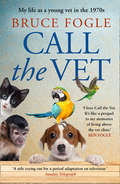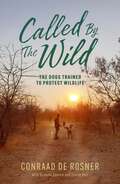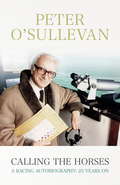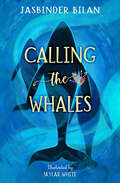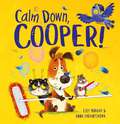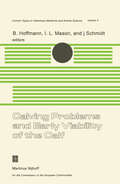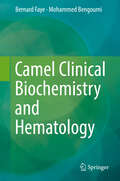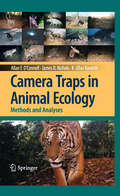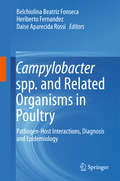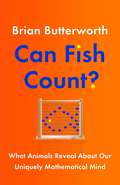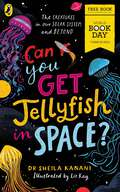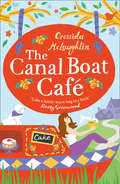- Table View
- List View
Call the Puffins: Book 3 (Call the Puffins #3)
by Cath HoweThird in a delightful new series about puffins and teamwork for readers aged 5+.Welcome back to the island of Egg, where a group of young puffins are training to join a search and rescue team.Meet Forti, the newest recruit. He's a bit of a dreamer and the other puffins have their work cut out looking after him!When an old wreck washes up in a storm, the puffins are told to keep away - but Forti cannot resist swimming right up to it for a closer look. But then disaster strikes and Forti's leg gets stuck in the rigging. Can Muffin, Tiny and the other puffins remain unflappable in the face of danger and save the day?
Call the Vet: My Life As A Young Vet In 1970s London
by Bruce FogleArriving in 1970s’ London as a fresh-faced Canadian, Bruce Fogle assumed that because he knew the language, he would understand the English. As a graduate of the world’s best veterinary school, he also thought his profession would come naturally to him. He quickly learned not to make assumptions…
Called By The Wild: The Dogs Trained to Protect Wildlife
by Conrad De Rosner Elaine Bell Graham SpenceThe thrilling story of a pioneering conservationist working with dogs to protect wildlife from poachers. Conraad de Rosner is one of the first game rangers to focus on working with specially trained dogs to protect wildlife from poachers – both 'bushmeat' poachers, who use cruel snares to trap animals, and criminal syndicates killing for rhinoceros horn and capturing critically endangered pangolins, the most trafficked animal in the world. Con's life – constantly at risk from poachers, wildlife and even his own fellow rangers – has been saved on numerous occasions by his devoted canine companions. His first dog, Zingela, a Weimaraner, saved Con from near certain death at the hands of two fellow rangers; on another occasion, Zingela alerted Con to a concealed wounded buffalo, one of Africa's most dangerous animals, about to charge. When Zingela was tragically killed, hit by a car while Con was away, the only meagre consolation was that Con had kept Landa, one of the nine puppies sired by Zingela. Landa followed in his father's footsteps as the leader of the canine anti-poaching team that is still operating today. Con's story is an epic of modern-day African wildlife conservation, filled with courage, adventure and romance.
Callie's Kitten
by Adèle GerasPoor Callie feels totally ignored when a new baby arrives in the house. Even David - her special friend - pushes her away and no-one seems to appreciate the efforts she makes to welcome it. Even her carefully chosen gift (a dead bird) is greeted with horror rather than delight. And when she is banished to the kitchen, Callie sadly resolves that she is no longer wanted. She has no choice but to run away...
Calling The Horses: A Racing Autobiography
by Peter O'SullevanFor decades Peter O'Sullevan was one of the iconic sports commentators, providing the sound track for half a century of horseracing as he called home such legends of the sport as Arkle, Nijinsky, Red Rum and Desert Orchid. His rapid-fire commentary seemed to echo the sound of horses' hooves, and it was not long before he became known as 'The Voice of Racing'. But in addition to his legendary status as a TV personality, Peter O'Sullevan was also a notable journalist and much-admired writer, and it is a measure of his standing both within and beyond the world of racing that his compulsively readable autobiography Calling the Horses, first published in 1989 and reprinted eight times, reached the top of the SUNDAY TIMES non-fiction bestseller list. The most recent edition of Calling the Horses was published in 1994, and the twenty years since then have brought many fresh episodes in the ongoing Peter O'Sullevan story, including the last racing days of his great friend Lester Piggott in 1995, his commentary on the 'Bomb Scare' Grand National of 1997, and his retirement from the BBC. He also describes setting up the Sir Peter O'Sullevan Charitable Trust, which has raised over £3.5 million for animal welfare charities, as well as offering his appreciation of a new generation of racing heroes, including jockey AP McCoy, who has come to dominate jump racing in a manner unparalleled in any sport, and the wonder-horse Frankel. The heartening news for the legions of Peter O'Sullevan fans is that, despite his years, his enthusiasm for racing is undiminished, and so are the elegance, fluency and wit which infuse his writing style. This new and extensively updated edition of Calling the Horses is a very remarkable book by a very remarkable man.
Calling the Whales
by Jasbinder BilanWhen a majestic whale is stranded near their Scottish hometown, Tulsi and Satchen are determined to save it. But after their boat capsizes in a storm, they’re left dangerously adrift. Just as all seems lost, help arrives from an unexpected source … An adventure with a powerful eco message at its heart.
Calm Down, Cooper!
by Lily Murray Anna ChernyshovaOur hero, a characterful young puppy, is top-dog at home, and the happiest pooch in town. Until ... one day, a new pet arrives - a pesky parrot called Pandemonium (Pandy for short) and poor Cooper's perfect world is turned upside down.When his owner goes out for the day, entrusting our proud hero with the task of guarding the house for the very first time, the parrot decides to invite a few old friends over to hang out. One by one, as the parrot's increasingly exotic friends arrive, the noise and mess escalates.Chaos ensues and though Pandy thinks Cooper should just calm down and enjoy the party, the puppy starts to panic! Can he cope? How will he clean up in time? Will he still be the perfect pet in his owner’s eyes? Find out in this riotous rhyming tale which builds to a wonderfully witty ending.A hilarious picture book written by best-selling author Lily Murray and illustrated by Anna Chernyshova about unconditional love.
Calm Down, Zebra
by Lou KuenzlerA celebration of colours and patterns from the pair that brought you bestseller NOT YET, ZEBRA.Annie said to the animals, "Let's help baby Joe.He's learning his colours, which he doesn't yet know.I'll paint pictures of you - please line up for me.If I use the right colours then Joe will soon see."Everyone's favourite, enthusiastic zebra is back, eager to get in on the act as Annie tries to teach her little brother about colours. But although things don't turn out quite the way she imagines, together they make the world a brighter and more beautiful place!'A joy to read aloud . . . guaranteed to win the hearts of all little mischief-makers.' Lancashire Post
Calving Management and Newborn Calf Care: An interactive Textbook for Cattle Medicine and Obstetrics
by João Simões George StilwellThis comprehensive textbook provides detailed information on calving management in dairy and beef cattle. Enriched with diverse learning opportunities, it conveys the fundamentals of reproductive anatomy and physiology, parturition, birth complications and various obstetrical manoeuvres, as well as dam and calf care. In order to promote best practices in this specialized subject, the book covers all significant points from conception to calving and the perinatal period. Clear chapter structures, a wealth of illustrations and videos, obstetrical case studies, and question-and-answer lists round out the reading experience, making the book a unique source of information on how to support mother cows and obtain viable offspring. In addition, readers can download the free Springer Nature Flashcards App and benefit from 77 digital study questions to test their knowledge.Calving is a significant event in terms of providing care and nutrition for mother cows and calves. The reproductive health status in cattle farms is crucial to immediately initiate lactation and new conception. Assistance by technical personnel, dystocia and stillbirth occurrences can reach ca. 50%, 14% and 6% of parturitions, respectively. Hence, zootechnical and veterinary management of calving is of great importance for animal welfare.This textbook makes a valuable contribution to teaching and everyday practice in cattle medicine and obstetrics. Veterinary students, residents, practitioners and technical personnel will discover it to be a rich learning and reference resource.
Calving Problems and Early Viability of the Calf: A Seminar in the EEC Programme of Coordination of Research on Beef Production held at Freising, Federal Republic of Germany, May 4–6, 1977 (Current Topics in Veterinary Medicine #4)
by J. Schmidt I. L. Mason B. HoffmannThis publication contains the proceedings of a seminar held in Germany (Fed. Rep.) on May 4 -6, 1977, under the auspices of the Commission of the European Communities, as part of the EEC programme of co ordination of research on beef production. The programme was drawn up by a combined scientific working group on Genetics and Selection and on Nutrition and Management on behalf of the Beef Production Committee. The working group consisted of Professor Dr. Neimann S~rensen (Denmark, Chairman), Dr. Brolund Larsen (Denmark), Mr. Boccard (France), Dr. H. de Boer (Netherlands), Priv.-Doz. Dr. B. Hoffmann (Germany, Fed. Rep.), Professor Dr. H.J. Langholz (Germany, Fed. Rep.), Dr. J.W.B. King (UK), Mr. R. Jarrige (France), Mr. B. Vissac (France), Professor Dr. A. Romita (Italy), Professor Dr. E.P. Cunningham (Ireland), Mr. P. L'Hermite (CEC) and Dr. J.C. Tayler (Scientific Adviser to CEC). The subject chosen for this seminar was drawn from the list of priorities in research objectives drawn up in 1973 by members of a committee (now the Standing Committee on Agricultural Research, (~PRA). One of the functions of this series of seminars was to summarise and update the information available on the selected subjects and to discuss future needs for research, so as to assist the Commission in evaluating the probable impact of research on agri cultural production within the Community.
Camel Clinical Biochemistry and Hematology
by Bernard Faye Mohammed BengoumiThis work brings together a wealth of data regarding the reference values and factors of variation in biochemical parameters used by camel veterinarians and scientists to determine these animals’ nutritional and clinical status. It also explores several technical aspects involved in determining these parameters, sampling procedures, and essential elements in the interpretation of the results. Though many texts are available on small and large ruminants, much less is known about species confined to the marginal zones of tropical and Mediterranean countries, such as camels. This book addresses precisely this research gap, on the one hand by presenting an extensive review of the literature, and on the other by synthesizing the outcomes of the authors’ numerous previous works. In veterinary medicine, blood tests to help diagnose diseases in cattle were first proposed nearly a century ago, but were mainly developed in the 1960s, initially at specialized research or veterinary services laboratories, and eventually, with the advent of new equipment and the miniaturization of the analyzers, finding their way into veterinarians’ cabinets. Beyond their diagnostic value, veterinary surgeons and zootechnicians also speculated on the potential use of blood tests to evaluate animals’ nutritional status. Thus, a whole range of analyses are now proposed to the stakeholders responsible for animal health. Such analyses could help to define a metabolic profile, which would offer a valuable decision-making tool for experts and researchers alike.
Camel (Large Print)
This is a picture of a two-humped camel, standing facing left. There is a locator dot shown, which will be at the top left of the page when the image is the right way up. At the left centre is its head shown from the side with its mouth, one eye and two ears. To the right of its head are the camel's humps each one with rough hair on top. Lower down the page is the body of the camel with its tail to the far right. Lower still are the camel's four legs with its large, flat, two-toed feet at the bottom of the page.
Camel (UEB Contracted)
This is a picture of a two-humped camel, standing facing left. There is a locator dot shown, which will be at the top left of the page when the image is the right way up. At the left centre is its head shown from the side with its mouth, one eye and two ears. To the right of its head are the camel's humps each one with rough hair on top. Lower down the page is the body of the camel with its tail to the far right. Lower still are the camel's four legs with its large, flat, two-toed feet at the bottom of the page.
Camel (UEB uncontracted)
This is a picture of a two-humped camel, standing facing left. There is a locator dot shown, which will be at the top left of the page when the image is the right way up. At the left centre is its head shown from the side with its mouth, one eye and two ears. To the right of its head are the camel's humps each one with rough hair on top. Lower down the page is the body of the camel with its tail to the far right. Lower still are the camel's four legs with its large, flat, two-toed feet at the bottom of the page.
Camera Traps in Animal Ecology: Methods and Analyses
by Allan F. O’Connell, James D. Nichols and K. Ullas KaranthRemote photography and infrared sensors are widely used in the sampling of wildlife populations worldwide, especially for cryptic or elusive species. Guiding the practitioner through the entire process of using camera traps, this book is the first to compile state-of-the-art sampling techniques for the purpose of conducting high-quality science or effective management. Chapters on the evaluation of equipment, field sampling designs, and data analysis methods provide a coherent framework for making inferences about the abundance, species richness, and occupancy of sampled animals. The volume introduces new models that will revolutionize use of camera data to estimate population density, such as the newly developed spatial capture–recapture models. It also includes richly detailed case studies of camera trap work on some of the world’s most charismatic, elusive, and endangered wildlife species. Indispensible to wildlife conservationists, ecologists, biologists, and conservation agencies around the world, the text provides a thorough review of the subject as well as a forecast for the use of remote photography in natural resource conservation over the next few decades.
Campylobacter spp. and Related Organisms in Poultry: Pathogen-Host Interactions, Diagnosis and Epidemiology
by Belchiolina Beatriz Fonseca Heriberto Fernandez Daise Aparecida RossiThis book provides an extensive review of research into Campylobacter, Helicobacter and Arcobacter species found in poultry. It includes the epidemiology, diagnosis, immune response and disease control of these organisms in commercial poultry production. Antimicrobial resistance, and the incidence and human disease potential of these bacteria is also discussed. A global perspective is presented by experts from four continents – South America, North America, Europe and Africa. This reference work will be of value to the poultry industry, research laboratories, public health workers and students. An extensive overview of the relevant literature is provided by the reference lists at the end of each chapter.
Can Fish Count?: What Animals Reveal about our Uniquely Mathematical Mind
by Brian Butterworth'What I like best about this fascinating book is the detail. Brian Butterworth doesn't just tell us stories of animals with numerical abilities: he tells us about the underlying science. Elegantly written and a joy to read' Professor Ian Stewart, author of What's the Use? and Taming the InfiniteThe Hidden Genius of Animals: Every pet owner thinks their own dog, cat, fish or hamster is a genius. What makes CAN FISH COUNT? so exciting is the way it unveils just how widespread intelligence is in nature. Pioneering psychologist Brian Butterworth describes the extraordinary numerical feats of all manner of species ranging from primates and mammals to birds, reptiles, fish and insects. Whether it's lions deciding to fight or flee, frogs competing for mates, bees navigating their way to food sources, fish assessing which shoal to join, or jackdaws counting friends when joining a mob - every species shares an ability to count.Homo Sapiens may think maths is our exclusive domain, but this book shows that every creature shares a deep-seated Darwinian ability to understand the intrinsic language of our universe: mathematics CAN FISH COUNT? is that special sort of science book - a global authority in his field writing an anecdotally-rich and revelatory narrative which changes the way you perceive something we take for granted.
Can I Give My Stepkids Back?: A laugh out loud, uplifting page turner
by Aurelie Tramier"A wonderful story. I laughed - and cried - a lot! You have to read this." *****Anne-Christine, Amazon customer"Bitter sweet!" *****Amazon reviewer"A wonderful read full of depth and emotion"****Morgan, Netgalley reviewerAs a childcare centre director, Morgan has to deal with kids every day but would much rather run her own boarding kennel. Snoopy-Morgan's beagle-s indeed the only living being she has considered family these past few years. When her sister and brother-in-law die in a terrible car crash, she has no choice but to adopt their two children.The unexpected addition to her household is clearly unlikely to get her closer to her canine goals. And as if this wasn't enough, she seems to be getting it all wrong with her "stepkids", ordering bedding her new son Elliot finds terribly childish, and forgetting to bake a cake for school on Lea's birthday. Grandma Catherine is convinced she'd do a much better job...When Snoopy sprains his leg, the kids are swept off their feet by the handsome single vet who's nursing him back to health. They're convinced he and Morgan would be a match made in heaven. Now they only need to convince Morgan...
Can Reindeer Fly?: The Science of Christmas
by Roger HighfieldHow does snow form? Why are we always depressed after Christmas? How does Santa manage to deliver all those presents in one night? (He has, in fact, little over two ten-thousandths of a second to get between each of the 842 million households he must visit.) This book contains information on how drugs might make us see flying reindeer, how pollution is affecting the shape of Christmas trees, and the intriguing correlation between the length of our Christmas card list and brain size.
Can Squid Fly?: Answers to a Host of Fascinating Questions About the Sea and Sea Life
by Tony RiceUsing the same question and answer format of his highly successful first book Do Whales Get the Bends?,marine expert Tony Rice sets out to answer another selection of generalinterest questions about the sea, sea life and man's relationship withthe oceans. Questions tackled in this book include: * Did the Mediterranean once dry up? * What are sea wasps? * Why is a ship's control room called a bridge? * What is the Pacific Garbage Patch? * What causes the Northern/Southern Lights?Written in the same entertaining style as the first book, and once again illustrated with black and white line drawings, Can Squid Fly? will answer these and many more intriguing questions.Inspired by questions raised whilst the author was a guest lecturer oncruise ships, this fascinating and informative book is a light-heartedyet surprisingly informative read for anyone interested in the sea. Each bite-sizedentry is no more than two or three pages long, making it ideal to dipinto.
Can You Get Jellyfish in Space? (World Book Day 2024)
by Dr Sheila KananiYou've probably heard of dogs in space. Maybe even chimpanzees. But jellyfish? Almost certainly not!Join Dr Sheila Kanani in this special World Book Day adventure, as she discovers a weird and wonderful cast of animals who have travelled into space, from Ham the chimpanzee to Félicette the cat, and the 60,000 jellyfish who have orbited the Earth (did you know you can also get jellyfish-shaped galaxies?). You'll meet the microscopic creatures that can survive in the vacuum of space, and wonder – could aliens really exist?This fantastical journey into the wild and surprising realms of space weaves together astronomy, physics and biology, and is sure to inspire space-obsessed and animal-loving kids everywhere.
Canada Goose (Large Print)
In this image of a goose its head is at the top left of the page and its tail on the right. There is a locator dot shown, which will be at the top left of the page when the image is the right way up. Its beak is open, and to the right is its eye. The goose has a very long, black, straight neck. Its body is partially covered by a folded wing, and is in the centre of the page. The tail feathers droop down at the lower right of the page. The two short legs and large webbed feet are at the bottom of the page.
Canada Goose (UEB Contracted)
In this image of a goose its head is at the top left of the page and its tail on the right. There is a locator dot shown, which will be at the top left of the page when the image is the right way up. Its beak is open, and to the right is its eye. The goose has a very long, black, straight neck. Its body is partially covered by a folded wing, and is in the centre of the page. The tail feathers droop down at the lower right of the page. The two short legs and large webbed feet are at the bottom of the page.
Canada Goose (UEB Uncontracted)
In this image of a goose its head is at the top left of the page and its tail on the right. There is a locator dot shown, which will be at the top left of the page when the image is the right way up. Its beak is open, and to the right is its eye. The goose has a very long, black, straight neck. Its body is partially covered by a folded wing, and is in the centre of the page. The tail feathers droop down at the lower right of the page. The two short legs and large webbed feet are at the bottom of the page.
The Canal Boat Café: Port Out (The\canal Boat Café Christmas Ser. #1)
by Cressida McLaughlin‘Warm and wonderful…bursting with characters you’ll adore’ Miranda Dickinson

